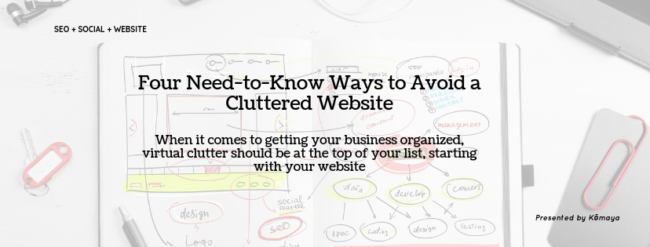Four Need-to-Know Ways to Avoid a Cluttered Website
When it comes to getting your business organized, virtual clutter should be at the top of your list, starting with your website
Is your business suffering from a cluttered website? You probably have already heard the term “virtual clutter” at some point since a good portion of our lives these days is kept on a computer or other device in the form of emails, text messages, documents, PDF files, images, videos and so much more. Once upon a time, for a business to run smoothly, you just needed a way to keep files organized and your desk cleared of any unnecessary papers. Nowadays, an organized physical space is not enough because the majority of companies operate a good portion of their businesses online.
Today, an organized physical workspace is not enough for a business to operate smoothly. If your website is cluttered you might as well be trying to run a company from under a mountain of paper and junk.
Virtual clutter mainly focuses on ways to keep your devices organized and your online presence clutter-free. For example, organizing emails into folders that are easier to find versus collecting virtual dust in your inbox. You can organize your desktop as well by using folders to sort similar items together. And of course, it’s always helpful to regularly delete any emails or documents that are no longer relevant. Platforms like Google Photos and Dropbox make it easy to store photos, videos, and documents in a safe place that doesn’t take up precious space on your hard drive.
These may seem like pretty simple ideas, but you would be surprised how many people don’t think about organizing their virtual lives. If and when they finally do, there’s so much data it can be overwhelming, to say the least. One thing that any savvy business owner should not overlook is a cluttered website because it’s the equivalent of having a sign for your business that is covered in graffiti. It makes it hard to read and turns people away. You have less than one second before a visitor forms an opinion about your website. If you can’t hold their attention, then odds are that they will leave your site and move on to the competition.
So, take some time right now to focus on the following four ways to make sure your website doesn’t cause people to scramble for the “X” button:
Make It User-Friendly
 One of the main things that make dealing with clutter so frustrating is how finding even the most basic item can become an extreme exercise in perseverance. If you are looking for a rubber band, you want to open a drawer, reach in and pull out a rubber band in a matter of seconds. You don’t want to waste time or energy, and you definitely don’t want to stress out over such a small thing.
One of the main things that make dealing with clutter so frustrating is how finding even the most basic item can become an extreme exercise in perseverance. If you are looking for a rubber band, you want to open a drawer, reach in and pull out a rubber band in a matter of seconds. You don’t want to waste time or energy, and you definitely don’t want to stress out over such a small thing.
When people visit your website, it is crucial that they are able to find out exactly what they need to know in a matter of seconds and without any stress. The last thing you want your website to do is frustrate potential customers. So when you are designing your website, make sure that amid all of the choices for layouts, elements, and fancy images, you don’t neglect the basics.
Your website should make it obvious from the very beginning WHAT your company does, WHY consumers need your product and/or service, and HOW they can get more information. If your site is so cluttered that these basics are hard to find, then it’s like having a closet crammed full of blankets when you really just want a pillow. It’s frustrating, unhelpful, and a big waste of time. No one is going to dig through the blankets, instead, the door is going to get slammed right away.
Keep Text to a Minimum
 If your home page and other landing pages are covered in lines and lines of text, then you will most likely lose any traffic that comes your way. An overwhelming amount of text is like having an unruly pile of laundry scattered across your floor – it’s not pleasant to look at and makes you want to leave the room. Since you don’t want people to leave your site as soon as they arrive, think minimalistically when it comes to text and opt for effective images instead.
If your home page and other landing pages are covered in lines and lines of text, then you will most likely lose any traffic that comes your way. An overwhelming amount of text is like having an unruly pile of laundry scattered across your floor – it’s not pleasant to look at and makes you want to leave the room. Since you don’t want people to leave your site as soon as they arrive, think minimalistically when it comes to text and opt for effective images instead.
Position text in a way that it isn’t punching your potential clients in the face as soon as they click on your page. This can be done by utilizing drop-down menus, having an appropriate amount of white space surrounding the text, and simply keeping the amount of text low. Of course, you want your site to have content, but don’t put it all on one page. For example, your site can feature a blog that can serve as an excellent place for your content to live. You can have a separate FAQ page that can provide a lot of information about your company, how it works, and products/services without having it all jammed on the first page that people see.
Limit Choices and Information
 Your website does not have to contain every single bit of information about your company, nor does it need to all be in one place. Remember, you want to feature the basics and provide information on how your customers can engage with you if they want to know more. In fact, you might be thinking that providing a large amount of information is helpful and what your customers want. Too many options create anxiety and leave us less satisfied.
Your website does not have to contain every single bit of information about your company, nor does it need to all be in one place. Remember, you want to feature the basics and provide information on how your customers can engage with you if they want to know more. In fact, you might be thinking that providing a large amount of information is helpful and what your customers want. Too many options create anxiety and leave us less satisfied.
Think about it like this – imagine that you decide you want to cook a meal and open up your pantry to see what you have available to prepare. The shelves are filled with dozens of cans of all different kinds of spices, soups, sauces, vegetables, canned meats, and some things you aren’t even sure what they are. You immediately shut down and order take-out. This is like a customer coming to your website and being confronted with so many options that they become overwhelmed, sign-off, and decide to binge-watch their favorite TV shows instead.
Update It Before It’s Outdated
 In organizing, systems are put in place to keep clutter at bay and make things work efficiently. These systems need to be regularly assessed to make sure they are still working as well as they were at the outset. Often, they need to be adapted and tweaked as times change in order for them to continue to work effectively.
In organizing, systems are put in place to keep clutter at bay and make things work efficiently. These systems need to be regularly assessed to make sure they are still working as well as they were at the outset. Often, they need to be adapted and tweaked as times change in order for them to continue to work effectively.
This same concept needs to be applied to your website. What works one week may not work the next. If it stays the same, then customers are likely going to look for a more updated site because they will assume that company is more “in-the-know”. Make it a priority to regularly check your website for any areas where it might be outdated and fix it as needed. This way, potential customers will associate your website with a driven company that keeps up with the latest trends.
Your website should make it obvious from the very beginning in a clear and understandable way, WHAT your company does, WHY consumers need your product and/or service and HOW they can get more information.
Basically, a successful business has many components that make it operate at an optimum level. One of the main factors to determine how smoothly a company runs is how well it is organized. When you declutter your workspace, including your files, schedule, and other physical aspects of your business, don’t forget to carry it over to the virtual side of the coin. If you take the time to keep your website clean and well-organized, you will attract more web traffic and retain more of the customers that find their way to your site. If you need a fresh set of eyes to get your website in tip-top shape and would like some feedback on how you can gain more customers, contact us today to see how we can help!
